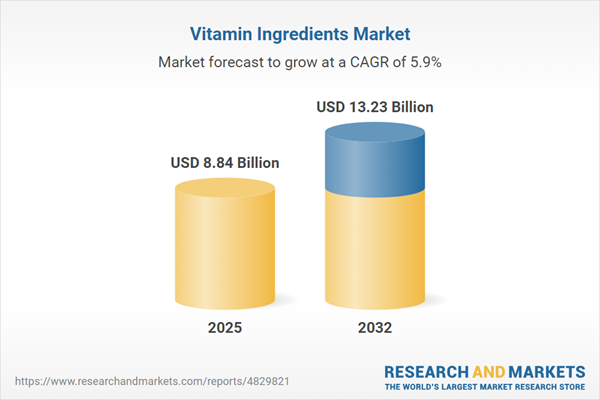Speak directly to the analyst to clarify any post sales queries you may have.
The vitamin ingredients market is evolving rapidly as senior leaders adapt to shifting buyer expectations, complex compliance demands, and the necessity for digital optimization across sourcing, operations, and risk management.
Market Snapshot: Growth Trajectory in the Vitamin Ingredients Market
The vitamin ingredients market reached USD 8.35 billion in 2024, with projections pointing to USD 8.84 billion in 2025 and USD 13.23 billion by 2032, representing a compound annual growth rate (CAGR) of 5.91%. Key drivers include a stronger consumer focus on wellness, expanding clean-label and personalized nutrition solutions, and significant advances in digital capabilities. As organizations respond to evolving global requirements, investments in digital tools streamline sourcing, improve compliance management, and reinforce operational agility. Companies prioritizing these enhancements are better positioned to align with sustainability objectives, navigate regulatory complexity, and capitalize on emerging B2B trends in the vitamin ingredients market.
Scope & Segmentation: Strategic Market Perspectives
- Ingredient Types: Multivitamin blends and individual nutrients, such as vitamins A, B-complex, C, D, E, and K, enable adaptable solutions for varied corporate, pharmaceutical, and specialized sector needs.
- Sources: Animal-based, plant-derived, fermentation-based, and synthetic origins allow organizations greater flexibility to meet procurement goals and comply with regional regulatory demands.
- Forms: Products are available in liquids, powders, softgels, capsules, and tablets, offering suppliers key opportunities to address institutional requirements and drive development through technology-driven forms.
- Applications: Vitamin ingredients serve uses in animal nutrition, dietary supplements, cosmetics, pharmaceuticals, and numerous food and beverage categories, including dairy, bakery, beverage, and confectionery, broadening both utility and reach.
- Distribution Channels: Supply chains leverage retail pharmacies, specialty outlets, supermarkets, hypermarkets, and robust e-commerce platforms to support multi-channel engagement strategies for both B2B and direct sales contexts.
- Regions Covered: The Americas, Europe, Asia-Pacific, and Middle East & Africa each present individual regulatory environments, making regional tailoring essential for effective growth and compliance management.
- Leading Companies: Key stakeholders—DSM-Firmenich AG, BASF SE, Archer-Daniels-Midland Company, Evonik Industries AG, Lonza Group Ltd, Zhejiang NHU Co., Ltd., Merck KGaA, Glanbia plc, Kemin Industries, Inc., Prinova Group LLC—anchor consistent supply and ongoing logistics improvement across the sector.
Key Takeaways for Strategic Leadership
- Expanding supply chain transparency through traceability technologies builds trust among global business partners and supports seamless compliance.
- Adopting advanced digital analytics and marketplace platforms accelerates access to market intelligence and fosters quicker, more informed decision-making at the executive level.
- Improving compliance management with updated labeling, tracking, and risk mitigation practices lowers entry barriers and supports adherence to dynamic international regulations.
- Innovations in delivery formats, such as encapsulation techniques, unlock new application areas and allow businesses to differentiate within key segments.
- Supplier diversification and expanded geographic sourcing enable organizations to safeguard continuity and reduce risk from supply chain disruptions or raw material shortages.
- Integrating sustainable procurement practices aligns business goals with stakeholder expectations and strengthens readiness for stricter regulatory standards worldwide.
Tariff Impact: Navigating U.S. Policy Shifts
Recent changes in U.S. tariff policy are leading organizations to revisit their sourcing structures, emphasize domestic manufacturing, and diversify supplier partnerships. These measures bolster supply chain resilience amid ongoing policy developments.
Methodology & Data Sources
This analysis is supported by interviews with senior executives, supply chain experts, and regulatory officials. Conclusions draw on sector-specific reports, current trade statistics, and detailed filings to deliver a robust and actionable assessment.
Why This Report Matters
- Provides timely insights for addressing regulatory change and adapting operational processes through digital integration.
- Equips leaders with strategies that enhance compliance, create resilient supply chains, and anticipate industry trends in a volatile environment.
- Supports effective planning for new market entry and product expansion with a focus on innovation and data-driven decisions.
Conclusion
Combining digital innovation, transparent sourcing, and responsive compliance enables senior leaders to guide their organizations through the ongoing transformation of the vitamin ingredients sector.
Additional Product Information:
- Purchase of this report includes 1 year online access with quarterly updates.
- This report can be updated on request. Please contact our Customer Experience team using the Ask a Question widget on our website.
Table of Contents
3. Executive Summary
4. Market Overview
7. Cumulative Impact of Artificial Intelligence 2025
Companies Mentioned
The companies profiled in this Vitamin Ingredients market report include:- DSM-Firmenich AG
- BASF SE
- Archer-Daniels-Midland Company
- Evonik Industries AG
- Lonza Group Ltd
- Zhejiang NHU Co., Ltd.
- Merck KGaA
- Glanbia PLC
- Kemin Industries, Inc.
- Prinova Group LLC
Table Information
| Report Attribute | Details |
|---|---|
| No. of Pages | 196 |
| Published | November 2025 |
| Forecast Period | 2025 - 2032 |
| Estimated Market Value ( USD | $ 8.84 Billion |
| Forecasted Market Value ( USD | $ 13.23 Billion |
| Compound Annual Growth Rate | 5.9% |
| Regions Covered | Global |
| No. of Companies Mentioned | 11 |









